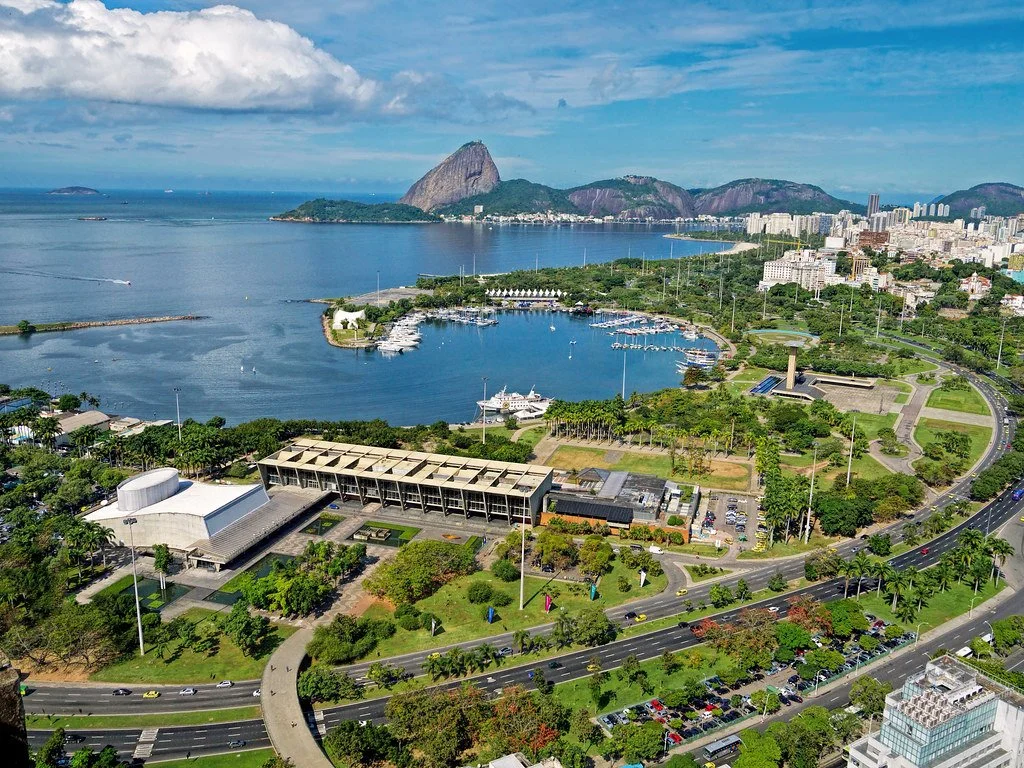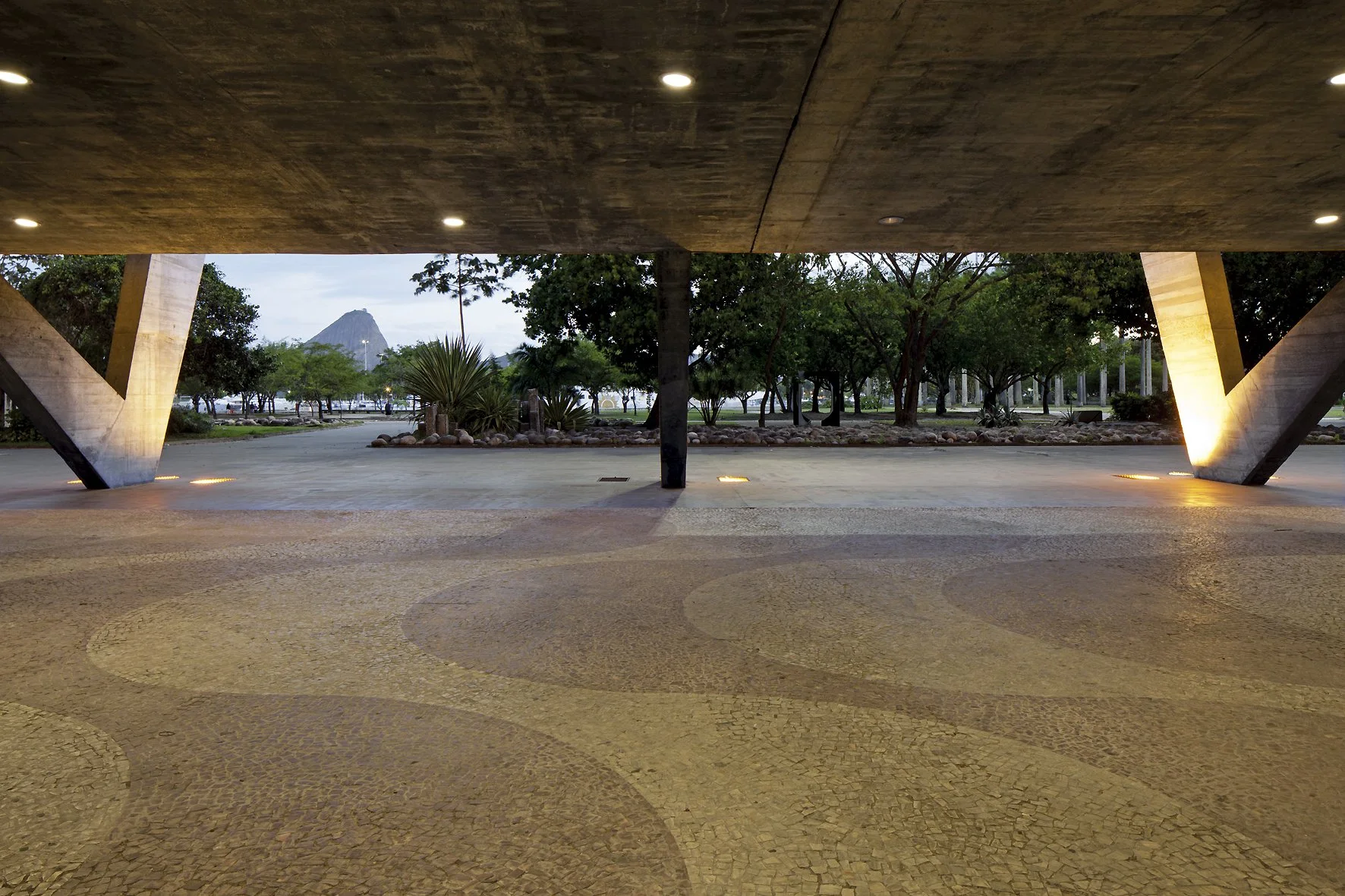
The Museum of Modern Art in Rio and Cultural Hierarchy in Brazil
The Museum of Modern Art in Rio (MAM) was built in 1948 inside Burle Marx’s Aterro do Flamengo (Flamengo Park). In a neighborhood of mostly high-income residential buildings that offer views across the bay, the park (about 300 acres) appears as an elongated public meeting ground for residents from elsewhere in the city. Even so, some areas are still heavily segregated, such as the park’s marina for private yachts. MAM is located at the park’s northern end, near the airport and the historic city center, which today is mostly occupied by commercial buildings and public agencies’ headquarters. [Image 01]
Designed by Affonso E. Reidy, the museum opened in 1948 as a public non-profit organization. The modernist building stands on 14 concrete V-shaped diagonal frames that lift it from the ground, creating over 1000 sqm (10,000 sqf) of open space that creates the impression – in perfect modernist terms – that the park actually flows under and through the building. It only touches the ground with an enclosed shop at one end and the stairs that access the first floor. [Image 02] This case study will analyze how the supposedly-universal realm at the street level contrasts with a national history of undervalued culture and cultural hierarchy, and with challenges to publicness caused by political and economic circumstances.
MAM, Aterro do Flamengo and the Sugar Loaf, 2020
Source: Flickr Leonardo Martins
Construction of the museum
Source: MAM Archive
One must first analyze Brazil’s recent history of cultural buildings and a systemic undervaluing of culture by the federal and state government. . Underfunding and poor management preceded a devastating fire at the MAM in 1978 that destroyed 90% of its collection, including paintings by Salvador Dali, Joan Miró, Picasso, Henri Matisse, Rene Magritte, Portinari e Di Cavalcanti. Since then, the museum has been able to create a substantial collection although half was donated by a single French-Brazilian art collector. Sadly, the National Museum collapsed under flames in 2018 and the library of the Federal University of Rio de Janeiro burned in 2020. Institutional neglect and governmental austerity spiraled and have led to a public withdrawal from cultural buildings. [Image 03, 04]
MAM’s new collection and temporary exhibitions are spread between two upper floors, open from 10:00 to 18:00 with free admission and no dress code. The museum is also known for hosting public events, including carnival parades on the ground floor and in the surrounding areas of the park. However, the upper floors of the museum are entirely controlled and surveillance is constant. Despite the publicness of the ground, the upper floors of the museum evidence a more traditional institutional level of control and surveillance. While in many ways a necessity of an art collection, in Rio, it reflects a long-standing social hierarchy that literally excludes many from public spaces, and makes others feel excluded as well. However, on rare occasions, public events create the opportunity for everyone to feel welcomed into the space.
Fire that destroyed MAM, 1978
Source: MAM Archive
National Museum’s fire covered by the NYT, 2018
Source: The New York Times
Recently, a controversial 2021 decision by the city to allow only private carnival parties in order to reduce gatherings during COVID led to the privatization of the ground-level space of the museum and the park. For the first time, a carnival party on the ground floor of the museum had a fee of 40 to 80 BRL. However, this was not the first time one had to pay to take part in events at the museum. Apart from the public parties or those organized by the museum, it has become common in recent years to rent upstairs spaces for private events primarily to compensate for the lack of government funding. This creates different levels of publicness within the spaces controlled by the museum. While on one extreme the ground floor represents infinite publicness – until the recent private party; on the other, large spaces for private parties above are among the most expensive venues available in the city.
Like many museums around the world, MAM exhibitions and maintenance are supported by a vast list of sponsors and partners. Donors range from private companies, public national companies, investment funds, international banks, the city of Rio itself, members, and individuals. But in Rio, this framework became more extreme following financial crises during the 2010s, leading to the sale of a Jackson Pollock painting in 2018 for 12 million USD. To restructure the museum financially, the latest board of directors led by Fabio Szwarcwald established a partnership in 2020 with the Brazil Foundation, in New York. This strategy enabled MAM to match the tax deduction policies of American museums like the Guggenheim and MoMA, among others. The museum grew from three main sponsors to 25 in 2020, and 38 in 2021. Yet, like many institutions, the COVID-19 pandemic put extreme financial pressure on the museum, including the loss of its space rental business - it caused a loss of 2.5 million BRL in revenue. [Image 05]
List of donors and sponsors, 2022
Source: MAM’s website
Financial aspects aside, the infinite publicness of the ground floor and MAM’s lack of a physical boundary allows for it to be a continuation of Burle Marx’s park. The museum website claims that: “MAM understands the pilotis, the garden, and all surrounding areas of the museum as public spaces, partially under the museum’s jurisdiction.” These “shared spaces … promote creation and exchange between every person that uses it, without discrimination”. It represents an ideal public realm… perhaps flawed, perhaps impossible. Unlike many other modernist attempts to create a fully open ground plane, Reidy was successful (although he passed away before the building’s completion) and the open space has been maintained for decades. In Rio, other buildings from the same period were altered by permanent or temporary fences and gates. At Pedregulho and Minhocão, two noted housing complexes by the same architect, similar enclosures fractured the intended public realm. The fact that the museum is a public non-profit organization allows for the maintenance of modernist ideals, here expressed at its best.
There are no (apparent) surveillance cameras or guards, even though the museum hired a private security firm. There is also no sign stating rules and allowed activities. At first, a passerby might not even recognize what happens over their heads, although the silence might give a hint. The universal realm physically invites everyone to the space. However, as previously stated, culture can become an invisible barrier. [Image 06]
Ground-floor: universal realm, 2022
Source: Leonardo Finotti
Recently, the MAM board has been trying to reverse the perception of exclusion. Recognizing the importance of the museum as part of a larger social infrastructure system, they invested in collaborations with public schools and sought to extend its spaces beyond the physical realm - especially due to COVID restrictions. With that vision, MAM hosted an exhibition in 2016 with photographs by dwellers from nine different slums in Rio. It was a partnership between the City Hall of Rio, MAM, and the Secretariat of Culture - where students would receive special training and a phone to take the photographs. Also, from 2020 exhibitions are fully accessible by a free virtual tour. It is another part of the museum’s education program - which opened even before the museum itself hosted its first exhibition. However, the impact of those virtual spaces and new technology on city form is yet to be seen. It might attract visitors to the museum but also result in a further withdrawal from the physical space.
In sum, Reidy’s modernist gem is a perfect example, if also a wish or aspiration, of a universal public realm yet impeded by public perception of culture as a privileged activity. It is the case of a public non-profit space failed by the public sector and undervalued on a national scale. MAM today appears to be part of a social infrastructure struggling to overcome an exclusionary role to reach public schools and attract the broader public. The reframing of the museum is going against the trend in other museums in Rio and abroad, where expensive entrance fees and excessive physical barriers separate urban life from the galleries. MAM aims - and partially succeeds - to be a continuation of an expansive urban park – an indoor and outdoor garden where all are welcomed.
Bibliography
Alan Latham and Jack Layton, "Social Infrastructure and the Public Life of Cities: Studying Urban Sociality and Public Spaces," Geography Compass 13 (2019) 1-15
Matthew Carmona, "Contemporary Public Space: Critique and Classification," Journal of Urban Design 15: 1 (February 2010) 123–148.
Laura Wolf-Powers, "Keeping Counterpublics Alive in Planning," in Connolly, et. al, eds., Searching for the Just City: Debates in Urban Theory and Practice (2009) 161-172.
https://riomemorias.com.br/memoria/acervo-do-mam/
https://www.select.art.br/quem-tem-medo-de-um-museu-em-revolucao/






